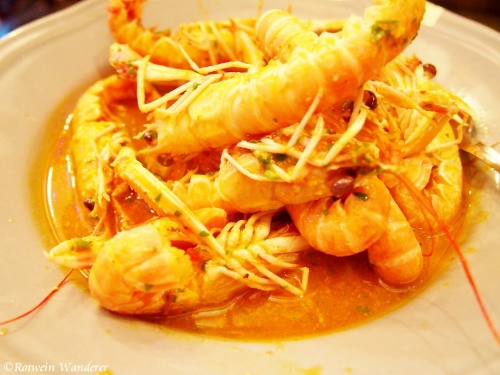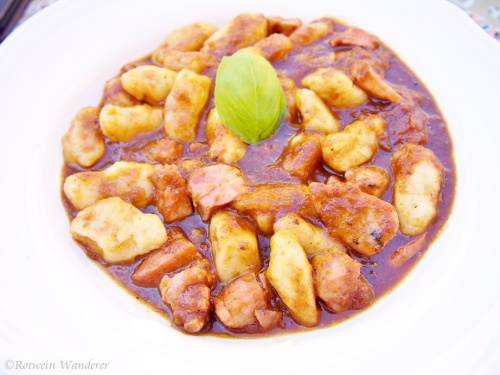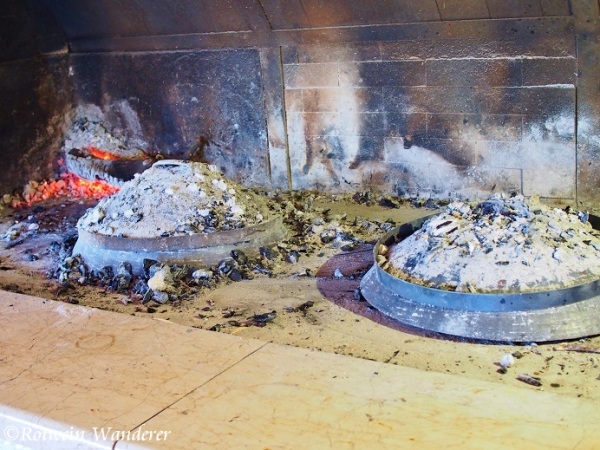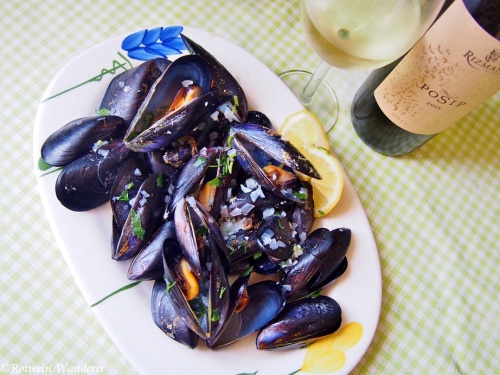The Nanbanzuke recipe I posted earlier this month intended to allude this Sardine Escabeche recipe.
I came across savur, a.k.a. ‘savor’ or ‘saor’, Croatian escabeche when I was making my ‘To-Eat in Croatia’ list picking out the local dishes from Taste of Croatia. It describes savur that ‘Traditional way of preparing and preserving fish, usually sardines and anchovies, that is very popular in regions where ancient Venetian republic ruled but very similar recipe can be found even in distant Japan’, which attracted my interest on the propagation: the Portuguese or Spanish dish was passed on eastward – e.g. to the Mediterranean regions, Philippines, Japan etc. as I mentioned on the Nanbanzuke post (also spread westward to their colonies in the new continent as well, though).
Unfortunately, I had no opportunity to try escabeche in Croatia, so I made it myself referencing a recipe on the web and adding some changes.

Ingredients
(for 2 servings)
6 butterflied sardine fillet
salt and pepper
15 g plain flour
15 g cornstarch
50 ml olive oil, to shallow fry
[Marinade]
100 ml water
75 ml white wine vinegar (acidity 6%)
60 ml white wine (I used medium bodied Riesling)
½ tsp caster sugar
60 g red onion, finely sliced
30 g carrot, julienned
30 g celery, julienned
3 small sun-dried tomatoes, rinsed and chopped
½ tbsp salted capers, rinsed
1 garlic clove, crushed
¼ tsp fennel seeds
1 dried bay leaf
fresh rosemary springs
fresh sage leaves
1 tbsp juice of fresh lemon
extra virgin olive oil, to garnish
sweet paprika, to garnish (optional)
celery leaf or flat leaf parsley, to garnish (optional)

Method
- Season the fish with salt and pepper, and lightly dust with a mix of the flour and starch. Heat the olive oil in a pan and fry over medium heat, skin-side down until lightly brown and drain excess oil. Set them aside in a wide non-reactive tray.
- Place the celery, carrot, onion, sun-dried tomatoes, capers, bay leaf, rosemary, sage, fennel seeds, sugar, vinegar, water and wine in a non-reactive saucepan, bring to the boil over medium heat, then reduce the heat and leave to simmer gently for a few minutes. Remove from the heat, allow to cool slightly, and pour over the fish. Set aside to cool completely, and scatter the lemon juice before place in a fridge. Leave for at least 2 hours or overnight to marinate.
- On a platter, top with sardines, garnish with the paprika and green leaves, then drizzle with extra virgin olive oil when serve.
I tried as many dishes as I listed whilst in Croatia this summer and learnt that Croatian cuisine has received influences from neibouring cultures and the countries ruled the territory of Croatia throughout history. It has similarities with Italian, Austrian, Hungarian, Turkish etc., but each region has its own distinct culinary traditions. I stayed mostly in Split and Dubrovnik, the coastal Croatia, and enjoyed lots of seafood cooked in traditional Dalmatian way.
Seafood Dishes




Meat Dishes

I tried Ćevapčići in Bosnia Herzegovina where it is considered a national dish. Ćevapi or Ćevapčići is well known and eaten in all parts of the former Yugoslavia once under the Ottoman Empire. Next time Dubrovnik, I will try Taj Mahal (funny, it’s not an Indian restaurant!) near Lapad, not in the Old Town, to explore more about Bosnian food. Sofra in Zagreb was pretty good.

Those I mentioned above were all nice, however, what I enjoyed more was the food cooked with bare minimum of seasoning and really brings out the full original flavour of ingredients.

The octopus salad at Konoba Menego on Hvar Island is highly recommended. All the ingredients were fresh and tasty, especially the caper! They don’t sell their homemade capers, unfortunately…. Instead, they advised me to find ones preserved in vinegar at farmers’ market. Their cheese and dry-cured ham platter looked yum.

In Dalmatia, fresh seafood grilled over open flame is superb. It is simple, but tastes different as it is cooked with fresh olive oil and Mediterranean herbs over olive tree or grapevine wood fire, which gives it deep flavour. So the grilled meat and vegetables are flavourful, too.
 grilled sea bass @ Miličić Winery
grilled sea bass @ Miličić Winery
Lady Pi-Pi, one of MUST places in Dubronik, offers delicious BBQ food at reasonable price considering to the location (within the Wall), a great view over the Old Town and good atmosphere under the grape trellis. They don’t accept reservations, so I avoided dinner time and dropped in just before lunch time (breakfast is served until 11:00). I had to wait a bit for a table to be ready, but there wasn’t a queue.

You absolutely must try peka while in Dalmatia! Peka is a slowly baked dish with meat or seafood along with vegetables in a pot or tray, but it is actually a method of cooking, and also a dome or bell-shaped ceramic or metal lid. The dish is also called ispod čripnje, or ‘under the bell’ – food cooked under the bell-shaped lid in fireplace.

The lid is covered with hot coals while the ingredients are being slowly cooked in their own juices under the ‘bell’. That is why they are moist and flavoursome. It is said that it probably is the oldest way of food preparation in the Adriatic, even Mediterranean area – according to some archaeological researches, the artifacts of peka was found in the layers of Bronze Age.
It may be a primitive way of cooking, but the result is more than satisfying!! Even the potatoes accompanied by were moreish!

I wish I could have joined sunset tuk tuk tour followed by dinner at Konoba Dubrava, one of the most popular peka places in Dubrovnik! Unfortunately, it was not available for just one person…. Anyway, I had a chance to try some, which was divine!

Some locals I met while in Dubrovnik dreamily said octopus peka is scrumptious and much tastier than meat one. It was too late to notice some restaurants near Polače Port in Mljet serve octopus peka – little time was left until departure back to Dubrovnik…. Peka usually needs to be ordered in advance and takes some time to be prepared. Stop by and ask restaurant staff before you visit the Mljet National Park if you make a day trip to the island.

In Dubrovnik, I rented a holiday apartment halfway between the Old Town and Gruž Port – less expensive and much quieter than staying inside the Wall. There are very frequent bus services to/from the centre until late, however, it was just about 20 minute walk and very safe even at night. I sometimes walked down for a glass of wine or a scoop of ice cream enjoying cool evening air after dinner at the apartment.
There are fish and green markets near the port, where I popped in almost every day to get some fresh fruits for breakfast, and vegetables etc. for my cooking. I cannot recall well, but I think the mussels were about 15-20 kunas per 1kg.


Dalmatian cheese and dry-cured ham also are a must, which I shall mention when I write about Croatian wines.


I haven’t been to Croatia but this will be a great guide anytime I decide to go. Thank you 🙂
LikeLiked by 1 person
My pleasure. You wold love the cuisine!!
LikeLiked by 1 person
The dish looks so very tasty! I love the use of fennel seeds and sage in there. I wish I could get some decent fresh sardines here, but it’s almost impossible. But I’ll keep this in mind for if and when… 🙂
Interesting to read about Croatian cuisine. The flavors and ingredients are definitely up my alley. I do hope to be able to visit this area sometime.
LikeLiked by 1 person
Sorry to hear the fresh ones are not easily obtainable…. Do visit Croatia someday! I found them interesting, esp. they way they use herbs!
LikeLiked by 1 person
I can get them in New York relatively easily when in season, but they’re not as good as the Israeli ones. Visiting Croatia is definitely on the bucket list! 🙂
LikeLiked by 1 person
What a shame you could not join the tour. Looks like a great time. I think I could enjoy a lot of the vegetables.
LikeLiked by 1 person
Maybe next time! Yes, charcoal grilled vegetables were so good!
LikeLike
What a yummy dish this is ❤
LikeLiked by 1 person
Croatia is on my list of places to visit!
LikeLiked by 1 person
Please do! and eat/drink a lot!!
LikeLiked by 1 person
I will!
LikeLike